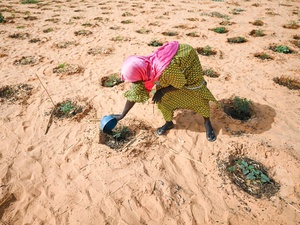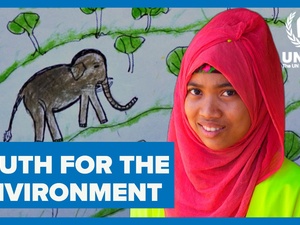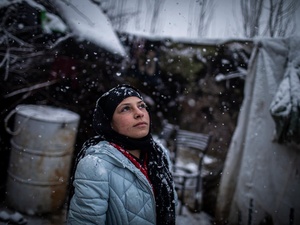'Climate change is the defining crisis of our time and it particularly impacts the displaced'

'Climate change is the defining crisis of our time and it particularly impacts the displaced'
In 2019, weather-related hazards triggered some 24.9 million displacements in 140 countries. Research shows that without ambitious climate action and disaster risk reduction, climate-related disasters could double the number of people requiring humanitarian assistance to over 200 million each year by 2050. Andrew Harper, UNHCR’s Special Advisor on Climate Action, sat down with UNHCR’s global website editor Tim Gaynor in Geneva to assess the current situation and how UNHCR and its partners need to act now to avoid being overwhelmed.
How big an impact is climate change going to have on the worlds’ most vulnerable people?
Climate change is the defining crisis of our time and its impacts are unevenly weighted against the world’s most vulnerable people. Displaced and stateless people are among those in greatest need of protection.
Under rapid global warming, extreme weather – heavy rainfall, drought, heatwaves, tropical storms – are becoming more unpredictable, intense and frequent, and increasing the risk of further rapid- and slow-onset hazards including floods, landslides, erosion, wildfires and desertification. At the same time, sea level rise is bringing increased coastal flooding, erosion, soil salinization and the threat of permanent inundation in low-lying areas.
Vulnerable communities are already experiencing climate impacts on food, water, land and other ecosystem services necessary for human health, livelihoods, settlement and survival. Women, children, older people, people with disabilities and indigenous peoples are disproportionately affected.
Resilience to climate shocks, environmental degradation and displacement is often lowest in fragile and conflict-affected contexts. Seven of the 10 countries most vulnerable and least prepared to deal with climate change, host a peacekeeping operation or special political mission. The impacts of climate change may exacerbate conflict dynamics and other drivers of conflict and fragility.
The eight worst food crises in 2019, all in countries where UNHCR is operating were linked to both climate shocks and conflict. Without ambitious climate action and disaster risk reduction, climate-related disasters could double the number of people requiring humanitarian assistance to over 200 million each year by 2050.
UNHCR is a refugee protection agency. Why should it be involved in responding to displacement in the context of climate change?
As a refugee protection agency, we are obviously concerned with people who have been displaced by conflict or persecution across international borders. While it may be challenging to make that direct link between climate change and people crossing an international border, we can see that climate change is a risk multiplier, or a threat multiplier, for other drivers of displacement.
Climate change does not in itself lead to conflict, but it does increase food insecurity. It increases challenges to access to livelihoods and it puts pressure on education and health services. This is often compounded with pressures on governance and access to overall resources, and when you have challenges in relation to socio-political and religious grievances, or community structures, the combination of factors could be the spark to set everything off.
Unless all concerned actors take proactive measures to mitigate those vulnerabilities, we can expect increased conflict in the future. This is where we are focusing now. We need to better integrate the current knowledge and the science in order to make much more informed decisions. We need to make the linkage between climate change, vulnerability, and displacement in order to anticipate at risk populations well in advance. By using anticipatory approaches we can become a less reactive agency that is better prepared to provide protection and address the most urgent challenges now and in the future.
Where are we already seeing the interplay between climate change, conflict and displacement?
The Sahel region is one of the clearest examples of how climate change can interact negatively with other megatrends. For instance, in the Sahel there is massive population increase taking place where we expect to see almost a doubling of the population in the next 20 or 30 years. At the same time the World Bank is reporting that the productivity of the land in the Sahel has dropped by another 30 or 40 per cent.
Altogether you have an increase in the population, a decrease of the productivity of the land, at the same time there are questions regarding governance. These factors combined may threaten survival for the most vulnerable and adds to stress in the region, which may create a high risk of conflict.
So, the issue is, will it only be the Sahel facing these challenges, or can we expect to see similar trends emerging in other regions, notably West Africa or Southern Africa? It’s no use simply looking at conflict once it arrives. We must anticipate where climate change is going to exacerbate underlying trends, crises and fragilities in order to have a plan in advance of a conflict breaking out.
Where else are you seeing those trends emerge?
Each region has its own set of challenges regarding climate change, and each context will create different vulnerabilities and specificities. However, it’s important that we become more adept at anticipating the impact of climate change on different regions in five, 10, 15 years time so that we can put programmes in place which already address the vulnerabilities we expect to see. We should invest now rather than wait for people to become so vulnerable they have to move.
To do this, we’ve been looking at the modelling, and we are trying to build on the lessons learned from the work that’s been done to project future population movements in Central and South America based off of climate projections. One idea is to use that modelling methodology in other areas including the Sahel, Southern Africa and South Asia.
We are also looking at the South Pacific region, which faces the risk of sea level rise. What will that do to the concept of the territorial integrity of states? What will that do for the potential for statelessness? These are questions we need to ask, and answer, before it is too late.
We are also seeing that when people are forced to move by climate change and conflict, it’s very rare for them to return. In the past return was a truly durable solution once a conflict was over. Now with climate change and environmental degradation rendering areas of return too dangerous to live in or too fragile to support large populations, many people have nowhere viable to go back to. It changes how UNHCR has to look at and approach durable solutions in the future.

Rohingya refugees walk through a heavy monsoon downpour at Kutupalong refugee camp, Bangladesh, June 2018.
The term ‘climate refugee’ is gaining ground in the media, but the 1951 Refugee Convention doesn’t make provisions for people displaced by climate change. If people are forced to move beyond their borders, what protections are there?
The vast majority of people displaced by climate-related threats, remain within the borders of their countries. Over time, UNHCR has played an important role in supporting international, regional, national and sub-national development of laws and policies relevant for internally displaced people. Our objective is to build up national resilience and capacity to provide support to the population, so they’re not forced to move beyond the national borders.
For those who are driven to cross an international border, the global legal framework for international refugee protection may be applicable and may serve to effectively extend international protection. In particular, where the effects of climate change and disaster interact with violence, conflict or persecution that lead to displacement, individuals may be refugees under the 1951 Refugee Convention. There’s no such thing as climate refugees per se, but that does not mean that the 1951 Refugee Convention could not apply in certain situations.
In addition, the OAU Convention and Cartagena Declaration include broader refugee criteria that recognize, as refugees, those who, owing to “events seriously disturbing public order” are compelled to leave their country. These protection mechanisms can provide a degree of security and protection to people who have fled threats due to natural hazards. We aim to ensure that the existing protection mechanisms are fully utilized.
Ruling on a complaint by a Kiribati resident seeking asylum from the effects of rising sea levels, the UN Human Rights Committee found in January that countries may not deport individuals who face climate change-induced conditions that violate the right to life. Did Ioane Teitiota’s case open a door to the reevaluation of climate change as grounds for seeking asylum?
It was an interesting decision because it noted that, under international human rights law, even those who aren’t “refugees” have the right not to be returned to a country if doing so would cause a risk of irreparable harm to their right to life. The Committee noted that “without robust national and international efforts, the effects of climate change in receiving states may expose individuals to a violation of their rights” such that other countries could not send them back.
The Committee determined that in Teitiota's specific case, his his right to life was not violated because, despite the serious situation in Kiribati, sufficient protection measures were put in place. However, it’s a huge acknowledgement that the impacts of climate change may create a need for international protection in the future – even if it didn’t apply in Teitiota’s case. So it does open the door for increased analysis and review of the needs for international protection.
Even though the Committee found there were insufficient grounds in the case of Tetiota, given the likelihood of increased sea level rise in places like Kiribati, those grounds may be met in the future. It provides a basis to look more at what mitigation and adaptation would be required in order to enable people to safely stay on their land and with their communities. That’s the essence of it. These locations are going to become even less habitable in the future, so we have to be very much at the cutting edge of discussing how we can support resilience, preparedness and adaptation programmes in these areas for both displaced and host communities.
This is where for instance the Global Refugee Forum (GRF) in Geneva last year was so important for building strategic partnerships with development agencies and with regional institutions. The next step is to be much more anticipatory. We need to be an organization that is fit for the future, not only for the here and now. We are not looking to extend our mandate; we are looking to make protection is in place for those who will need it.
What is UNHCR doing to mitigate the environmental impact of refugee camps and settlements?
This year we developed a Strategic Framework on Climate Action, which covers three pillars of response. The first pillar speaks to the legal and normative work regarding protection for people being forced to move due to climate change. The overall goal is to support access to protection for people displaced in the context of climate change and disasters through guiding the interpretation and application of relevant legal and policy frameworks, developing guidance and catalyzing international discussions. The Department of International Protection has also just released a legal considerations paper on the international protection needs of the populations.
The third pillar speaks to what UNHCR is doing to green itself. We are looking to improve environmental sustainability by reducing our greenhouse gas emissions and minimizing negative impacts on the environment. A focus will be on improving data collection on our energy use, and identifying areas to transition to sustainable, and preferably renewable energy.
The second pillar is the most relevant to your question. It speaks to what are we doing to enhance the resilience of displaced persons to climate and other environmental risks and strengthen preparedness and resilience in disaster situations. This includes supporting environmental management and renewable energy in displacement settings.
For example, Kutupalong camp in the Cox’s Bazar district of Bangladesh has received an influx of more than 700,000 Rohingya refugees who fled Myanmar since August 2017. When the refugees arrived, the only source of cooking fuel was the nearby forests, and in a short time the area was cut down. Straight after that we provided people with Liquid Petroleum Gas, which meant that they didn’t have to cut down the trees. Not only is that good for people’s health because they won’t be breathing in the carbon from the trees that they were burning, but it also protected the forests around the camp, which contributes to disaster risk reduction through the stabilization of soil, reducing the risk of landslides. By providing clean alternative energy and reforesting the land, the whole community is more resilient to natural hazards and extreme weather.
We are also looking at trying to find ways to scale up from micro-projects and look to invest in the environment or energy initiatives that build into national environment plans, national adaptation plans and sustainable energy plans. The increase in scale is critical. Planting 100 hectares of trees is not enough. We’ve got to plant 100,000 hectares. We need to do things at scale, and we need to make sure that the local community sees that there is a net benefit.
What impact has the COVID-19 pandemic had on climate vulnerable groups? Does the global response have any upsides?
Displaced populations often have precarious livelihoods, reduced or no access to social safety nets and health services. These vulnerabilities are exacerbated for those in “climate hotspots”, or where livelihoods are already at risk due to climate change and environmental degradation. COVID-19 adds an extra layer of vulnerability
For example, certain populations living in vulnerable camps or settlements in West Africa, or South Africa or in South Asia were able to work, but since the pandemic they’ve lost their jobs. So rather than being able to provide income streams back to these settlements this adds to the strain and vulnerability of that context. It’s created a double blow in that regard. It’s exacerbated some of the environmental degradation in some of those areas as well.
But the global response to COVID-19 may hold some useful lessons. It shows that if we want to mitigate the impact of a disaster we need to be prepared to act quickly and in a holistic manner. If we ignore it, then we will face serious consequences. The challenge with combatting climate change is that the response required is more complex. As indigenous activist Hindou Ibrahim recently said at the opening session of the High Commissioner’s Dialogue “You cannot wear a mask for climate change. There is no vaccine against climate change.” This is serious. We need to be responding more urgently and decisively than we have done with COVID-19, and that is not what’s happening at the moment.
If we could compress the time between now and the next 20 or 30 years, and people could see the scope of the disaster that’s about to befall us, then we might see some action. Unfortunately, for now it’s just being kicked down the road. And today within different organizations, including ours, we don’t necessarily see the appropriate sense of urgency. It’s a difficult problem to solve. While true climate change denial is uncommon, the systematic failure to adequately mitigate and prepare defies all reason and is a more subtle form of denial we now must overcome.
What do you see as the most urgent priority for you and your team in the next 12 months?
Now that we’ve developed the Strategic Framework, it’s to operationalize it. We will go out to the various regions, identify our partners from within the UN country team, the national authorities and the communities on the ground. Together we will establish what the priorities are and where we can make a difference.
We need to be asking how we position ourselves to not only respond to current protection needs, but rather to become a proactive protection agency that mitigates the need for protection in the future? I think that’s also what governments will want us to do.
The GRF and the Global Compact on Refugees should provide us with the incentive, as well as the responsibility sharing framework, to mitigate the impact of climate change in the future on refugee and host populations. That means we need to be working with development actors, with the private sector, with communities and with the national authorities because that will help us focus on unified strategic positioning, and working together we can better achieve results at scale that have real impact and are anchored in to what the community needs on the ground.










